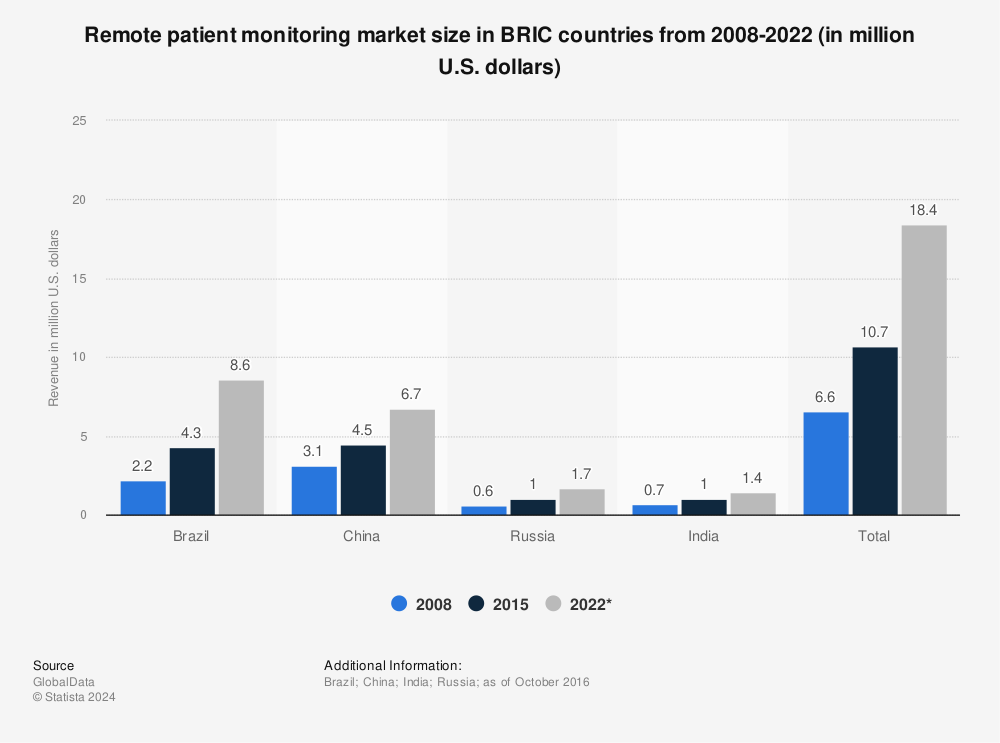Remote patient monitoring involves the monitoring of patients in the healthcare industry. Heart rate, neurological activity, respiration and more can all be monitored from afar, providing better use of resources, faster response times and greater independence for patients.
Remote patient monitoring allows for healthcare professionals to monitor the condition of critical patients from anywhere in the world, thereby ensuring that they receive 24/7 care and observation and that emergencies can be responded to quickly and efficiently. At the same time however, remote patient monitoring allows for the optimum use of resources, so that professionals are not confined to a single room or a single patient but rather are free to spread their attention among different residents and still be on standby.
The patient monitoring market is a large one and as more advanced methods of measuring a patient’s health become available, we are likely to see it extend even further.
What Are Patient Monitoring Systems?
Patient monitoring systems are used to monitor specific patients and particularly to look at their target of interest. These include cardiac monitoring which will often use continuous electrocardiography to assess the heart rate and to look for inconsistencies or signs of an impending heart attack. Patients may wear smaller wrist-worn devices for a similar end.
Hemodynamic monitoring looks at such things as blood pressure, blood flow and more in order to look for other signs of impending attack, stroke or other issues. Blood glucose monitoring ensures that blood glucose has not dropped too low and is particularly useful for diabete patients.
Respiratory monitoring of course ensures that the patient is breathing correctly. Pulse oximetry looks at the saturation percentage of oxygen in the blood, capnography involves the measurement of CO2.
Neurological monitoring involves the monitoring of brain function. This may observe intracranial pressure or it may use electroencephalography to look for electrical activity in the brain.]
Together, these monitors provide a patient’s vital signs, and with remote monitoring, carers are able to leave the room while making sure that all these data points are at satisfactory levels.

Find more statistics at Statista
Looking After Your Relatives
Just as hospitals might use remote patient monitoring systems to keep a watchful eye on patients without being constantly tied to a single room or bed, commercial applications are also available to allow members of the public to take care of their own loved ones.
One option is to outsource care to a homecare agency, which will ensure that your loved one is getting check-ins and being monitored at least several times a day.
Homecare agencies are services for your elderly or infirm relatives that can help you to look after them and ensure they are happy and safe by going around to check on them on a regular basis. This means that you can share the duties and that they can also help your relative with their chores which may mean things like washing up or taking out the rubbish.
When someone is elderly so that it hurts to move, and perhaps has lost strength in their arms, then something like taking out the rubbish can become a serious problem. Not only is this potentially very painful, but it can also be potentially dangerous if they should fall and hurt themselves while they try. This can be enough to leave them dreading having to do it all day, or mean that they put off doing it all together and so live in squalor. By using homecare agencies however, you can take this burden away from them and this is a great way to improve their quality of life. Most homecare agencies are highly versatile and will enable you to hire them to do as much as they need to or as little as they need to to suit the requirements of your relative and their particular health condition.
At the same time your elderly relatives may also be in danger of hurting themselves even when they aren't performing such chores and they could fall at any time and not be found for a long time. This means of course that you need to check on them regularly and go round often to ensure that they haven't fallen and that they're okay.
A common way to ensure the health and safety of a patient is to use a medical alert system. This is a device that can be activated in order to call for help, should an individual find themselves feeling unwell or falling. Traditionally these would take the forms of ‘cords’ located in the corner of a room. However, that is limited in as much as it will only be useful if the patient should fall or have an attack when they are near to the cord in order to be able to pull it!
Today, many medical alert systems are instead worn on the wrist or on the chest. Here they can monitor heartrate by looking for changes in the color of the skin tone and can that way automatically alert a homecare agency to any change in heart function. Likewise, orientation sensors can be used to detect when a patient has fallen and this way may be used in order to alert medical professionals to a potential fall.
Meanwhile, other forms of surveillance such as IP CCTV cameras and other systems can similarly be used in order to ensure that patients are okay and that they aren’t in need of emergency medical attention at any given time. Of course there is a fine line to be walked so as not to interfere with their privacy.
But the point is, that just as remote patient monitoring can be used in order to prevent death and to make better use of resources in hospitals, it can also be used for outpatients in order to give them back some measure of freedom and independence, while removing the burden of care from their loved ones.
